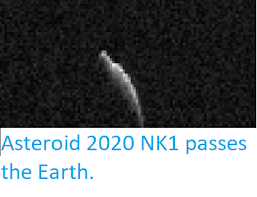Asteroid 2020 PW2 passed by the Earth at a distance of about 279 300 km (0.73 times the average distance between the Earth and the Moon, or 0.19% of the distance between the Earth and the Sun), at about 4.25 am GMT on Friday 14 August 2020. There was no danger of the asteroid hitting us, though were it to do so it would not have presented a significant threat. 2020 PW2 has an estimated equivalent diameter of 3-11 m (i.e. it is estimated that a spherical object with the same volume would be 3-11 m in diameter), and an object of this size would be expected to explode in an airburst (an explosion caused by superheating from friction with the Earth's atmosphere, which is greater than that caused by simply falling, due to the orbital momentum of the asteroid) in the atmosphere more than 30 km above the ground, with only fragmentary material reaching the Earth's surface.
The orbit and current position of 2020 PW2. The Sky Live 3D Solar System Simulator.2020 PW2 was discovered on 14 August 2020 (the day of after its closest approach to the Earth) by the University of Tokyo's Kiso Observatory. The designation 2020 PW2 implies that the asteroid was the 70th object (asteroid W2 - in numbering asteroids the letters A-Y, excluding I, are assigned numbers from 1 to 24, with a number added to the end each time the alphabet is ended, so that A = 1, A1 = 25, A2 = 49, etc., which means that W2 = (24 x 2) + 22 = 70) discovered in the first half of August 2020 (period 2020 P).
2020 PW2 has a 644 day (1.76 year) orbital period, with an elliptical orbit tilted at an angle of 13.0° to the plain of the Solar System which takes in to 0.94 AU from the Sun (94% of the distance at which the Earth orbits the Sun) and out to 1.98 AU (198% of the distance at which the Earth orbits the Sun, and outside the orbit of the planet Mars). This means that close encounters between the asteroid and Earth are fairly common, with the last thought to have happened in April this year (2020) and the next predicted in September 2020. It is therefore classed as an Apollo Group Asteroid (an asteroid that is on average further from the Sun than the Earth, but which does get closer). 2020 PW2 also has occasional close encounters with the planets Mars, which it last came close to in November 1999.
See also...



Follow Sciency Thoughts on Facebook.




